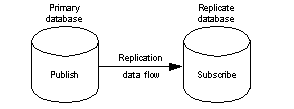A replication system maintains consistent, synchronized data in separate databases. It does that mainly by recording the data-changing operations in one database (called the primary database), and sending those operations to another database (called the replicate database). Data-changing operations thus captured and sent are called replicated transactions.
As shown in Figure 1-1, the primary database publishes replicated transactions, and the replicate database subscribes to replicated transactions.
Figure 1-1: Simple replication scenario

Figure 1-2 illustrates bidirectional replication, in which a single database acts as both a primary database and a replicate database. Bidirectional replication places a special requirement on a replication system. The system must be able to filter out replicated transactions that were received from another database to prevent circular replication back to the original primary database.
Figure 1-2: Bidirectional replication scenario
